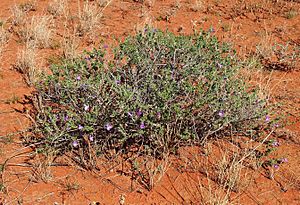Eremophila obovata facts for kids
Quick facts for kids Eremophila obovata |
|
|---|---|
 |
|
| Scientific classification | |
| Genus: |
Eremophila (plant)
|
| Species: |
obovata
|
The Eremophila obovata is a beautiful flowering plant that belongs to the figwort family. This plant is special because it is endemic to Australia, meaning it grows naturally only there. It's a small, bushy plant with lovely lilac to purple flowers. You can find it mostly in the Northern Territory and Queensland, but also in Western Australia, South Australia, and New South Wales.
Contents
What Does Eremophila obovata Look Like?
Eremophila obovata is a small, bushy plant that usually grows between 20 and 50 cm (8 and 20 in) tall. It has many branches that grow right from the ground. These branches are covered in soft, grey hairs, some of which are a bit sticky.
Its leaves are quite interesting! They can be shaped like a fan, a spoon, or an egg, but they are narrower at the bottom. The leaves are usually 4–28 mm (0.2–1 in) long and 2–11 mm (0.08–0.4 in) wide. They can be either hairy or smooth (without hairs).
The Flowers of Eremophila obovata
The flowers grow one by one where a leaf meets the stem. Each flower sits on a small stalk that is 3.5–9 mm (0.1–0.4 in) long. Before the flower opens, it is protected by five green, lance-shaped or triangular sepals. These sepals are usually 5.5–12 mm (0.2–0.5 in) long.
The petals of the flower are 16–24 mm (0.6–0.9 in) long and are joined together at their bottom to form a tube. The outside of this petal tube is lilac or purple. Inside, it is white with purple spots or streaks. The outside of the petals can be smooth or hairy. However, the inside of the petal tube is full of soft, fluffy hairs. The four parts that make pollen (called stamens) are hidden inside the petal tube.
This plant mainly flowers from June to October. After the flowers, it produces fruits that are oval or almost round. These fruits have a pale yellow, papery covering and are 6.5–9 mm (0.3–0.4 in) long.
Naming Eremophila obovata
This plant was first officially named and described in 1956 by a scientist named Lindsay Stuart Smith. His description was published in a scientific journal called Proceedings of the Royal Society of Queensland.
The second part of the plant's scientific name, obovata, comes from Latin words. "Ovatus" means "egg-shaped," and the prefix "ob" means "opposite." So, "obovata" means "reverse egg-shaped." This name refers to the unique shape of the plant's leaves.
Subspecies of Eremophila obovata
In 2007, another scientist named Robert Chinnock described two different types, or subspecies, of Eremophila obovata. These names are now officially accepted:
- Eremophila obovata L.S.Sm. subsp. obovata: This type has hairy leaves, and the outside of its sepals and petals are also hairy.
- Eremophila obovata subsp. glabriuscula Chinnock: This type has smooth leaves. Its sepals and petals might have a few hairs on the outside.
Where Does Eremophila obovata Grow?
Eremophila obovata is quite common in the south-east part of the Northern Territory and the south-west of Queensland. In Western Australia, you can find it along the Gary Junction Road in a desert area called the Gibson Desert. In South Australia, it only grows in the very north-east of the Lake Eyre botanical region. There is also one known record of it growing in the far north-west of New South Wales.
Is Eremophila obovata Protected?
The Western Australian Government's Department of Parks and Wildlife says that this plant species is "not threatened." This means it is not currently in danger of disappearing.
In the Northern Territory, the subspecies obovata is considered of "least concern," which is good news. However, the subspecies glabriuscula is listed as "data efficient," meaning more information is needed to fully understand its conservation status.
Growing Eremophila obovata in Gardens
This small plant often has flowers growing on its new branches, which makes it very attractive. The subspecies glabriuscula is especially popular because of its deep blue flowers and bright green leaves.
You can grow this plant from cuttings. Sometimes, it might send out new shoots from its roots. If this happens, it might be better to join it onto the root system of another plant (called grafting) using a Myoporum plant as the base.
Eremophila obovata grows best in soil that drains well and in a sunny spot. Even though it can handle dry conditions, giving it a good deep watering during a long dry period can help it produce lots of new flowers. It can also handle light frosts, but it doesn't like places with very high humidity.

